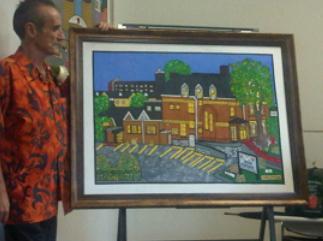All odds were against George MacIntyre.
The Toronto artist was living with HIV, and as he watched many of his friends succumb to the same disease he was battling, MacIntyre was doubtful he would live to complete the 12-part painting series he had been working on for more than a decade.
“I never dreamt I’d see the end of these paintings,” he says.
But now, MacIntyre’s completed collection, a tribute to some of Toronto’s most famous gay landmarks, is on display at the 519 Church St Community Centre. The final installation of the series, a painting of the Rosar-Morrison Funeral Home & Chapel, recently had its grand unveiling.
It was MacIntyre’s dream come true.
“It was a legacy I wanted to leave behind to educate people from all walks of life,” he says. “All my paintings have become my children.”
The series bears its origins in 1997, a time during which MacIntyre lived in Barrett House, a residence for those with HIV/AIDS. Inspired by staff and his “brothers” living with AIDS, MacIntyre embarked on a 15-year endeavour to document some of the city’s best-known gay monuments, including Woody’s, The Barn and The 519.
The final piece, a tribute to one of the first Toronto funeral homes to bury people who had died of AIDS, took more than three months to complete. Named Princess, after Rosar-Morrison owner James Munroe’s then-unborn daughter, the painting, MacIntyre says, was the most difficult in the series to complete.
“I had to paint over the first canvas with white paint to start over again,” he says. “But positive thinking brought me all the way.
“I had to carry on.”
A Summerside, PEI, native, MacIntyre began painting as a young boy. Though he has no formal art training, he says his talent came naturally.
“I had no lessons, but I painted all my life,” he says. “I’m still learning along the way.”
After he was rejected by most of his family because of his sexuality, MacIntyre made a move from the East Coast to Toronto, where he found solace and friendship within the walls of the landmarks he has painted.
“All the buildings that are captured are all very special,” he says. “In each of the paintings [the buildings] are brighter than their actual colour. I like making them brighter and shinier.
“It’s like bringing the inside of the buildings out.”
MacIntyre faced several obstacles in completing the series. While living in Barrett House, he fell ill and hit an all-time low weight of 90 pounds. Though he had doubts he would paint again, he bounced back.
He says he was most driven by the wish of his best friend Michelle DuBarry, who wanted him to complete the series. It’s what makes his work all the more inspiring.
“[DuBarry] said, ‘Finish all 12, and don’t forget me,’” he says. “So I did.”
Today, as he sports a collection of rainbow beads around his neck and a bright pink tote bag on his shoulder, MacIntyre is beaming; it’s hard not to imagine him behind an easel. He has been living with HIV/AIDS for 30 years; some dub him a walking miracle.
MacIntyre paints without commission; he says his only hope for the final unveiling of the series is that his work will inspire others.
“My dream is that there will be a day people will understand and see what I’ve done,” he says. “If I can do it, there are a lot more people out there that are HIV-positive or sick that can do something similar.”
MacIntyre hopes to continue his painting career. In fact, he has plans to start a new, six-part series this year.
He’s motivated to continue beating the odds.
MacIntyre’s collection is on display at The 519 Church St Community Centre.
For more info, visit the519.org.


 Why you can trust Xtra
Why you can trust Xtra


